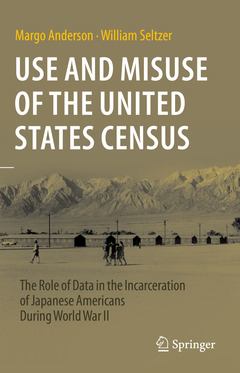Use and Misuse of the United States Census, 1st ed. 2023 The Role of Data in the Incarceration of Japanese Americans During World War II
Auteurs : Anderson Margo, Seltzer William

The U.S. government conducts a population census every 10 years, adds up the counts by geographic location, and uses the resulting numbers in formulas to allocate seats in the House of Representative and Electoral College, and to make public funding and tax decisions. It has served as an essential tool of representative democracy since 1790. The raw data from the census also serve as a decennial snapshot of the nation, a very long list, organized by household, ideally of all people resident on census day, with additional information on the name, age, race, sex, geographic location, and other characteristics for each individual.
Americans recognized early in their history that the raw data, the list, could serve additional governmental functions, and over the centuries, erected guardrails to prevent improper use. They are encapsulated in the presidential proclamations announcing the upcoming census. The information collected from individual households is for aggregated use only, and cannot be used for the ?taxation, regulation, or investigation? of individual persons or businesses.
Americans have heeded the call to ?stand up and be counted.? They also engage in an ongoing conversation to make sure that the information is used properly and ethically, that the census serves as a tool of representative democracy and advances the rights ? including human rights -- of all Americans. The record, however, reveals that there have been failures to meet this goal and that as a result the information provided by the responding public sometimes has been misused, causing considerable harm to vulnerable individuals, groups and entities.
Today, as governments and social media are suspect for their exploitation of data about individuals, the experience of Americans of Japanese ancestry in the United States during World War II provides a chilling example of such misuse of census data. This book reveals how census officials stepped beyond their normal roles as unobtrusive monitors of American demographic life and helped justify and administer the relocation and incarceration program.
Census officials mobilized the substantial administrative and technical resources of the 1940 census, to map the neighbourhoods where Japanese-Americans lived, and planned their systematic removal. The officials then built ?census-like? data systems to track the ?evacuees? for the duration of the war, monitor their lives in the camps, and certify which ?loyal? evacuees might be released from the camps for military or civilian service. After the war, census officials drafted an official history of their activities, but did not publish it. This book has lessons for policy makers and ordinary Americans alike, as we confront the new digital world in which we live. And it speaks to two of the great issues of our time: distrust in the institutions of government and the victimization of minorities.Chapter 1. Introduction.- Chapter 2. Before Pearl Harbor. - Chapter 3. December 1941.- Chapter 4. Executive Order 9066.- Chapter 5. June 1942 Evacuation.- Chapter 6. Military Area 2.- Chapter 7. Second War Powers Act.- Chapter 8. Commission of Wartime Reolcation and Internment of Civilians.
Margo Anderson is Distinguished Professor Emerita [History & Urban Studies] at the University of Wisconsin - Milwaukee. She specializes in American social, urban and women's history and has research interests in both urban history and the history of the social sciences and the development of statistical data systems, particularly the census. Her publications include the second edition of The American Census: A Social History (Yale University Press, 2015); Encyclopedia of the U.S. Census: From the Constitution to the American Community Survey (ACS), 2d ed.(Washington, D.C.: CQ Press, 2011), coedited with Constance F. Citro and Joseph J. Salvo; and a coedited volume with Victor Greene, Perspectives on Milwaukee's Past (University of Illinois Press, 2009). With UWM Professor Amanda Seligman, she is Lead Editor of the Encyclopedia of Milwaukee. In 2006 she served as the President of the Social Science His
Integrates the technical history of data collection, with the ethical and policy issues of official statistics
Educates a lay audience insight of the decision making of data collection and its impact
Explains why the Japanese Internment episode continues to challenge the Census Bureau, 80 years after the event
Date de parution : 01-2024
Ouvrage de 230 p.
15.5x23.5 cm
Thèmes d’Use and Misuse of the United States Census :
Mots-clés :
census; Statistical Confidentiality; Surveillance; Racial Targeting; World War II; Internal Security; Memory



